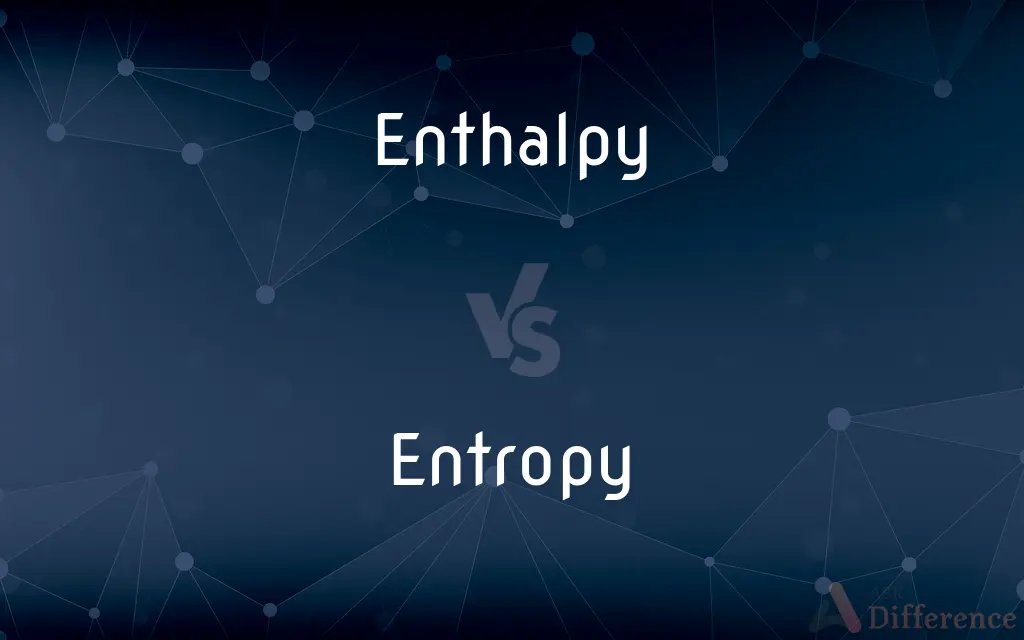Enthalpy vs. Entropy — What's the Difference?
By Maham Liaqat & Fiza Rafique — Updated on April 18, 2024
Enthalpy is a measure of the total heat content of a system, reflecting energy changes in chemical reactions at constant pressure, whereas entropy quantifies the disorder or randomness in a system, crucial for determining spontaneity.

Difference Between Enthalpy and Entropy
Table of Contents
ADVERTISEMENT
Key Differences
Enthalpy, represented as H, is a thermodynamic quantity used to express the internal energy of a system plus the product of its volume and the pressure exerted on it by its surroundings. On the other hand, entropy, denoted as S, measures the degree of disorder or randomness in the system, providing insight into the feasibility of a process under given conditions.
The change in enthalpy (ΔH) is a critical factor in chemical thermodynamics, indicating whether a process is endothermic (absorbs heat) or exothermic (releases heat). Whereas, the change in entropy (ΔS), helps determine whether a process can occur spontaneously, increasing in a system as it moves toward equilibrium.
Enthalpy changes are crucial in processes occurring at constant pressure, such as most biological and environmental systems. Conversely, entropy changes become particularly significant in processes where temperature and disorder vary, such as in melting, vaporization, and mixing.
Calculations of enthalpy are often used in designing energy-efficient systems, like engines and refrigerators, to maximize the energy output from a given input. Entropy calculations, however, are more often applied in understanding and predicting the direction of chemical reactions and the efficiency of heat engines.
While enthalpy is concerned with heat transfer in reactions, entropy provides a macroscopic view of molecular disorder and energy distribution, influencing the spontaneity of chemical processes and the possibility of achieving absolute zero temperature.
ADVERTISEMENT
Comparison Chart
Definition
Total heat content of a system
Measure of disorder or randomness
Symbol
H
S
Units
Joules (J)
Joules per Kelvin (J/K)
Role in Reactions
Measures heat absorbed or released
Determines reaction spontaneity
Importance
Critical in constant pressure processes
Key in processes involving temperature changes
Compare with Definitions
Enthalpy
A property of a system that combines internal energy and pressure-volume work.
The enthalpy change for the reaction helps determine how much heat is produced.
Entropy
Measures the randomness or unpredictability in a system.
Mixing different gases increases entropy due to increased randomness.
Enthalpy
Indicates whether a reaction is endothermic or exothermic.
A negative enthalpy change signifies an exothermic reaction.
Entropy
Used to determine the feasibility and spontaneity of a process.
A process with increasing entropy is more likely to occur spontaneously.
Enthalpy
Used to calculate heating and cooling in physical and chemical changes.
Enthalpy calculations are essential for designing HVAC systems.
Entropy
A thermodynamic quantity indicating system disorder.
Entropy increases as ice melts into water.
Enthalpy
Reflects the heat exchanged in a chemical process at constant pressure.
Measuring the enthalpy of combustion gives insights into fuel efficiency.
Entropy
Crucial for understanding the Second Law of Thermodynamics.
The Second Law states that entropy in an isolated system always increases.
Enthalpy
Integral to the First Law of Thermodynamics in expressing energy conservation.
Enthalpy is used in the First Law to describe how energy is conserved in a closed system.
Entropy
Affects the efficiency of heat engines and refrigerators.
Maximizing entropy change is key to improving engine efficiency.
Enthalpy
Enthalpy (listen) is a property of a thermodynamic system, and is defined as the sum of the system's internal energy and the product of its pressure and volume. It is a state function used in many measurements in chemical, biological, and physical systems at a constant pressure, that is conveniently provided by the large ambient atmosphere.
Entropy
Entropy is a scientific concept, as well as a measurable physical property that is most commonly associated with a state of disorder, randomness, or uncertainty. The term and the concept are used in diverse fields, from classical thermodynamics, where it was first recognized, to the microscopic description of nature in statistical physics, and to the principles of information theory.
Enthalpy
Symbol H A thermodynamic function of a system, equivalent to the sum of the internal energy of the system plus the product of its volume multiplied by the pressure exerted on it by its surroundings.
Entropy
Symbol S For a closed thermodynamic system, a quantitative measure of the amount of thermal energy not available to do work.
Enthalpy
A measure of the heat content of a chemical or physical system.
, where H is enthalpy, U is internal energy, p is pressure, and V is volume.
Entropy
A measure of the disorder or randomness in a closed system.
Enthalpy
(thermodynamics) a thermodynamic quantity equal to the internal energy of a system plus the product of its volume and pressure;
Enthalpy is the amount of energy in a system capable of doing mechanical work
Entropy
A measure of the loss of information in a transmitted message.
Entropy
The tendency for all matter and energy in the universe to evolve toward a state of inert uniformity.
Entropy
The deterioration of a system or society, especially when it seems inevitable
City activists who fought entropy by organizing neighborhood groups.
Entropy
A measure of the disorder present in a system.
Entropy
(Boltzmann definition) A measure of the disorder directly proportional to the natural logarithm of the number of microstates yielding an equivalent thermodynamic macrostate.
Entropy
(information theory) Shannon entropy
Entropy
A measure of the amount of energy in a physical system that cannot be used to do work.
Entropy
The capacity factor for thermal energy that is hidden with respect to temperature.
Entropy
The dispersal of energy; how much energy is spread out in a process, or how widely spread out it becomes, at a specific temperature.
Entropy
A measure of the amount of information and noise present in a signal.
Entropy
(uncountable) The tendency of a system that is left to itself to descend into chaos.
Entropy
A certain property of a body, expressed as a measurable quantity, such that when there is no communication of heat the quantity remains constant, but when heat enters or leaves the body the quantity increases or diminishes. If a small amount, h, of heat enters the body when its temperature is t in the thermodynamic scale the entropy of the body is increased by h ÷ t. The entropy is regarded as measured from some standard temperature and pressure. Sometimes called the thermodynamic function.
The entropy of the universe tends towards a maximum.
Entropy
(communication theory) a numerical measure of the uncertainty of an outcome;
The signal contained thousands of bits of information
Entropy
(thermodynamics) a thermodynamic quantity representing the amount of energy in a system that is no longer available for doing mechanical work;
Entropy increases as matter and energy in the universe degrade to an ultimate state of inert uniformity
Common Curiosities
What are practical examples of enthalpy use?
Enthalpy is used in calculating the energy requirements for heating and cooling systems, and in assessing reaction heat in chemical engineering.
Why is entropy considered a measure of disorder?
Entropy quantifies the number of microscopic configurations that correspond to a macroscopic state, with higher entropy reflecting greater disorder.
How do changes in entropy affect the environment?
Increased entropy in industrial processes often leads to greater energy dispersal, which can affect environmental energy flows and sustainability.
How do enthalpy and entropy relate to energy conservation?
Enthalpy is a measure of energy conservation under constant pressure, while entropy provides a criterion for energy dispersal in a system.
Can enthalpy and entropy changes indicate the direction of a chemical reaction?
Yes, negative enthalpy and positive entropy changes often indicate a reaction will proceed spontaneously.
What role does enthalpy play in phase changes?
Enthalpy changes describe the energy absorbed or released during phase changes, such as melting, vaporization, or condensation.
What determines if a process is endothermic or exothermic?
The sign of the enthalpy change; a negative ΔH indicates an exothermic process, and a positive ΔH indicates an endothermic process.
What is the significance of entropy in living systems?
Entropy in biological systems is important for understanding energy flow, organization, and the evolution of complex systems.
How does entropy relate to temperature?
Entropy increases with temperature as the molecular motion and disorder within a system increase.
Can entropy be reversed in a system?
In practical terms, entropy tends to increase; however, it can be locally decreased at the expense of greater increases elsewhere, consistent with the Second Law.
What is a common misconception about entropy?
A common misconception is that entropy implies total chaos; rather, it quantifies dispersal of energy and probability of states in a structured manner.
Why is understanding entropy important in technology?
Understanding entropy is crucial for designing more efficient systems that minimize energy waste, such as in computing and thermodynamic machines.
How does entropy affect the universe's fate?
The increase in universal entropy leads to predictions about the "heat death" where no more useful energy will be available.
What is the unit of measurement for enthalpy and entropy?
Enthalpy is measured in Joules, while entropy is measured in Joules per Kelvin.
How does enthalpy relate to the conservation of energy?
Enthalpy represents the total energy flow in a system, including both heat transfer and work done, underpinning energy conservation principles.
Share Your Discovery

Previous Comparison
Quenching vs. Tempering
Next Comparison
Durian vs. JackfruitAuthor Spotlight
Written by
Maham LiaqatCo-written by
Fiza RafiqueFiza Rafique is a skilled content writer at AskDifference.com, where she meticulously refines and enhances written pieces. Drawing from her vast editorial expertise, Fiza ensures clarity, accuracy, and precision in every article. Passionate about language, she continually seeks to elevate the quality of content for readers worldwide.














































